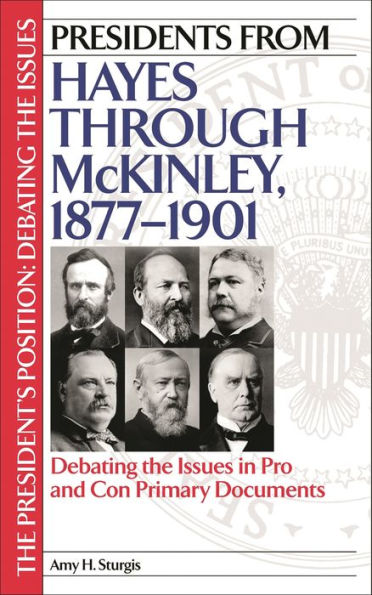Presidents from Hayes through McKinley, 1877-1901: Debating the Issues in Pro and Con Primary Documents
This resource of primary documents and commentary spans the Hayes and McKinley administrations, selecting and describing five to ten of the foremost issues of the day. The actual texts of the presidents' positions, along with the opposing viewpoints, are presented. Helpful background information and commentary clarifies the primary sources, accurately depicting this dynamic time in the country's past and providing an invaluable resource to any student of American history.
The period from 1877 to 1901 marked the end of one United States-a country still reeling from the Civil War, a divided nation of Reconstruction, a land of economic depression, sectional hostility, and governmental corruption. A new United States was emerging. It was an empire, an international power that both negotiated with and fought against European nations with great success, and a country with a rebounding economy, vigorous industry, and restored faith. During this Gilded Age, the nation expanded as settlers moved west and displaced native populations. Immigrants entered at the highest rate in the country's history. Geographic expansion gave rise to mighty railroads, and industrial expansion brought corporations, company towns, and monopolies. This unprecedented industrialism bolstered urban growth, yet economic hardships afflicted rural countrysides. Labor and agrarian interests organized.
1112047561
The period from 1877 to 1901 marked the end of one United States-a country still reeling from the Civil War, a divided nation of Reconstruction, a land of economic depression, sectional hostility, and governmental corruption. A new United States was emerging. It was an empire, an international power that both negotiated with and fought against European nations with great success, and a country with a rebounding economy, vigorous industry, and restored faith. During this Gilded Age, the nation expanded as settlers moved west and displaced native populations. Immigrants entered at the highest rate in the country's history. Geographic expansion gave rise to mighty railroads, and industrial expansion brought corporations, company towns, and monopolies. This unprecedented industrialism bolstered urban growth, yet economic hardships afflicted rural countrysides. Labor and agrarian interests organized.
Presidents from Hayes through McKinley, 1877-1901: Debating the Issues in Pro and Con Primary Documents
This resource of primary documents and commentary spans the Hayes and McKinley administrations, selecting and describing five to ten of the foremost issues of the day. The actual texts of the presidents' positions, along with the opposing viewpoints, are presented. Helpful background information and commentary clarifies the primary sources, accurately depicting this dynamic time in the country's past and providing an invaluable resource to any student of American history.
The period from 1877 to 1901 marked the end of one United States-a country still reeling from the Civil War, a divided nation of Reconstruction, a land of economic depression, sectional hostility, and governmental corruption. A new United States was emerging. It was an empire, an international power that both negotiated with and fought against European nations with great success, and a country with a rebounding economy, vigorous industry, and restored faith. During this Gilded Age, the nation expanded as settlers moved west and displaced native populations. Immigrants entered at the highest rate in the country's history. Geographic expansion gave rise to mighty railroads, and industrial expansion brought corporations, company towns, and monopolies. This unprecedented industrialism bolstered urban growth, yet economic hardships afflicted rural countrysides. Labor and agrarian interests organized.
The period from 1877 to 1901 marked the end of one United States-a country still reeling from the Civil War, a divided nation of Reconstruction, a land of economic depression, sectional hostility, and governmental corruption. A new United States was emerging. It was an empire, an international power that both negotiated with and fought against European nations with great success, and a country with a rebounding economy, vigorous industry, and restored faith. During this Gilded Age, the nation expanded as settlers moved west and displaced native populations. Immigrants entered at the highest rate in the country's history. Geographic expansion gave rise to mighty railroads, and industrial expansion brought corporations, company towns, and monopolies. This unprecedented industrialism bolstered urban growth, yet economic hardships afflicted rural countrysides. Labor and agrarian interests organized.
85.0
In Stock
5
1

Presidents from Hayes through McKinley, 1877-1901: Debating the Issues in Pro and Con Primary Documents
256
Presidents from Hayes through McKinley, 1877-1901: Debating the Issues in Pro and Con Primary Documents
256Hardcover
$85.00
85.0
In Stock

Product Details
| ISBN-13: | 9780313317125 |
|---|---|
| Publisher: | Bloomsbury Academic |
| Publication date: | 11/30/2003 |
| Series: | The President's Position: Debating the Issues |
| Pages: | 256 |
| Product dimensions: | 6.14(w) x 9.21(h) x 0.62(d) |
| Lexile: | 1460L (what's this?) |
About the Author
From the B&N Reads Blog
